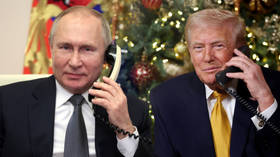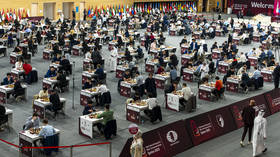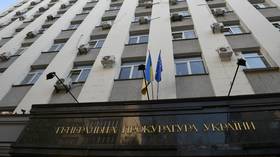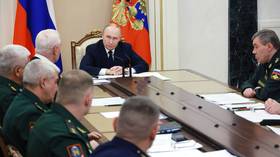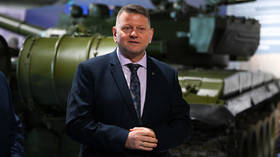“Anyone in Iran can buy the New Testament"

Just few days ago we saw how the small conflict between two families in the village in Egypt was transformed into a huge demonstration in Cairo. Why do we see this and never see how Christians and Muslims live in peace?
The Western media is not familiar with the phenomenon of mutual respect between the Christian and Muslim religions. The phenomenon does exist, however: Christians and Muslims showed their unity over the three week-long protest rallies in Egypt. Western TV companies avoided the subject. Christians have been respected in the Muslim world for the past 14 centuries. A group of RT reporters visited the temples of three Christian communities in Iran and recorded Christians’ accounts of their life in the Islamic Republic.Assyrian Church priest Rien Issa was transferred to Tehran from Vatican two months ago following a six-month training course. Rien is an Iranian, fluent in Farsi and in European languages. He refuses to speak on camera but our off-the-record conversation goes far beyond the five-minute frame that I originally set for it. “Our large temple is rarely full. A lot of the congregation has left. The US is doing all they can to allow them to leave Iran. They simplify the procedures. They go to Vienna first to wait for 3 to 5 months. Each of them is paid. They are promised a lot. Special people work with our Christians. They talk them into things. The young ones agree, especially if they are having trouble finding a job. Many of them regret their decisions. Many write to us from the US and say they’d made a big mistake. It’s hard for them to come back because they usually sell their houses. Almost all of the families who live abroad send their children here for holidays to maintain their link with their homeland", Rien said. Services are conducted in Assyrian, some prayers are read in Farsi. Tomorrow Issa will depart for the city of Ahvaz in the south.“There are 25 families there waiting for a priest. Our bishop is currently in Rome, the other priest is in Hamedan, so I have to travel. We have eight dioceses in Iran. Two hospitages, and two schools for girls and boys. Most of the pupils are Muslim. They appreciate the education we give. We teach languages well and have a computer class.”
Unlike Catholics in the West, Assyrian church priests are allowed to marry. “It doesn’t matter if you’re a monk or not, if you live as a monk in the temple. The bishop lives here too. So does another retired priest. The married ones live outside.”My interviewee was named after Jesus Christ. Muslims name their children after Christ quite often, since they revere the Christian messiah as a prophet.“A lot of Muslims come here to pray. They put up candles. Mary is the bridge between Christianity and Islam, you know. They are not changing their religion even though some of them sometimes come to us for a paper that says they’re Christians so they can go abroad,” the priest said. “I am 33. It’s a good age for a Christian,” Issa said. “Yes, we are a minority. There is only 7,000 of us and we can’t, for instance, march out into the streets in liturgical procession. But you know, I don’t wear my priest’s outfit or collar in Rome. But I do in Iran. I can feel that people have great respect for the fact that I am a Christian, a priest and a monk.”
The reason Muslims don’t mind crosses
The crosses on the Church of St. Sarkis can be seen from afar, standing out against a portrait of Imam Khomeini. Tehranis don’t think any of this is strange. Only one Muslim professor with whom we drive past the church can’t believe his own eyes, so we have to make a U-turn and drive past it again, giving him a photo opportunity, which he gladly uses. He asks us who it is on the picture. Upon being told that the portrait is of the leader of the Islamic revolution, he ask the driver to make another U-turn to make sure the church is there and he isn’t seeing things.The temple of St. Sarkis has a huge front yard and dozens of parking spots, all full. Nearby is a memorial to the Armenian genocide. An airy auditorium is full of bare-headed girls, chattering in English.
Mr. Sebos Sarkisian, head of the church chancellery, clearly doesn’t want to talk to me, but I have a document from the Ershad (the Ministry of Culture and Islamic Guidance Network). Members of the congregation and clergy pop into the room from time to time but leave quickly. I get my camera out. Mr. Sarkisian makes a decisive gesture: he will not let us take pictures. He would be glad to get rid of me, but a letter from the Ershad allows me to ask questions.Only a year ago people in the very same church would talk to me without looking back. Now they won’t say a word even though I have official permission. The first time I came to Iran I was working for a newspaper. Now I am working for a television channel. I could see very well how tired the Iranians are of journalists who tell them one thing and then show something completely different.“Don’t be offended. You know, Western television can make even the most harmless footage look as though people are being discriminated against here. Have you ever seen a Christian persecuted in Iran?” a girl asks me, dodging my camera.“The oldest church in Iran was built in the 1st century A.D. It is called the Karakilisa, meaning “Black Church.” The church is home to the remains of St. Tatevos (known to us as St. Jude the apostle),” says Sebos Sarkisian, lulling me to sleep while keeping an eye on what I am writing.“Christians lived in Isfahan back when it was still the capital. The soil and living conditions there are very good. Christians always took part in public affairs. Because Christ told us to love and respect each other, have you heard of that?”, he seems unsure that there are people outside of Iran who follow Christ’s teachings. I tell him that I’ve been to Isfahan and know how Armenians live there, but it does not affect his vigilant attitude in the least. “Christians took part in the war with Iraq. Have you heard of that war? We have over 100 shahids and more than a 100 people missing. About 30 were heavily wounded and incapacitated. The shahids are martyrs. Have you heard of Christian martyrs?” . His impression of journalists seems very clear. I have read in books that there are approximately 215,000 Christians in Iran. Perhaps even 300,000? Is that true?Mr. Sarkisian seems amazed that I read books. He goes up to his closet, takes out a couple of hefty tomes and presents me with an Armenian encyclopedia. “We have two deputies in the parliament, one from the southern provinces and one from the north,” he seems to change his mind at the last minute about asking me if I had heard about parliaments.He tells me that Christian churches in Iran are built to house up to 750 congregants.“No way!” I utter. Luckily, our translator chooses to let that slip.Sarkisian undertakes to explain to me that there is a book called the constitution, a book of laws protecting religious communities.“Do you know what a constitution is?”, he asks. “We have Christian schools, Armenian schools funded by the state. Our church alone has 24 schools in Tehran, and we have kindergartens as well,” Sebos Sarkisian continues proudly. “We also have our own gym, and the state allocated funds to equip it with a praying room, a namaz-khane.”“Don’t worry, she knows what a praying room is, she even knows what namaz is", says my translator. I am granted permission to enter the church.
“Churches are tax-exempt in Iran”
Sunday is a working day in Iran; yet the Orthodox St. Nicolas Cathedral, one of the 40 Christian churches, is open.“We've been having services both on Fridays and Sundays for the past six months, as it is convenient to people,” says church warden Emmanuil Shirani, a descendant of white emigres from St. Petersburg.“Iranians often come here – our service is in Russian, and they find it interesting,” says Shirani with a distinct pre-revolution St. Petersburg accent. That’s the Russian that has been spoken in his family.
For the story in pictures, visit the RT gallery "Christians in Iran"
“The Bible has been available in Farsi since before the revolution – that’s when it was translated first, and there have been a few new editions and new translation since then. The Ershad makes sure it’s available. It’s available on sale as any other book", continues Shirani, opening a freshly printed Bible book in Farsi to show me. “Like any other religious community, we are tax exempt. The local authorities are helping us. For example, they arrange food deliveries for the elderly at our hospice. They send in gardeners to tend to our gardens. We get to pay a special electricity fare, just like the mosques,” says the warden.“Our hospice currently accommodates 30 elders, and our canteen caters for them and an additional 60 people. City authorities help us with insurance; they pay for the services of both doctors and chefs. Some doctors help us free of charge, some charge half the price – and they do it out of respect for Christians, that’s the tradition here,” says Emmanuil Shirani, while greeting a group of hospice elders coming back from a walk.“We employ a Robin Hood principle: we charge those who can afford it and keep those who can’t for free,” he says.Grigory is the one watching over the church. He is 89. He was born in Soviet Russia in 1922, and his family moved to Iran when he was 5 – they left Baku by sea. His father was an army officer, and his mother came from a wealthy family. Today, he has three daughters and many grandchildren. He visited Russia only two years ago.As we are talking, a couple of dozen young people come to the church, both parishioners and visitors, families from Ukraine, Russia and Belarus.“Our church was built in 1944 by Cossacks. Then, when the Anglo-Soviet invasion happened, and many parishioners fled to Australia. After the war the church was closed down, and reopened in the 1990s. These days, we have about 60-70 people coming for Easter. The elders keep dying, that’s why,” explains Grigory, flipping through his family photos.
Nadezhda Kevorkova, RT





